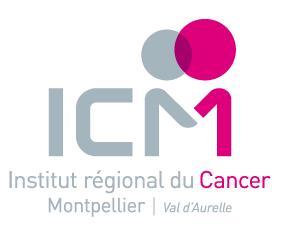Pravastatin Reverses Established Radiation-Induced Cutaneous and Subcutaneous Fibrosis in Patients With Head and Neck Cancer: Results of the Biology-Driven Phase 2 Clinical Trial Pravacur
Résumé
PURPOSE:The "PRAVACUR" phase 2 trial (NCT01268202) assessed the efficacy of pravastatin as an antifibrotic agent in patients with established cutaneous and subcutaneous radiation-induced fibrosis (RIF) after head and neck squamous cell carcinoma (HNSCC) radiation therapy and/or radiochemotherapy.METHODS AND MATERIALS:The main inclusion criteria were: NSCC in remission, grade ≥2 cutaneous and subcutaneous neck RIF (National Cancer Institute Common Terminology Criteria for Adverse Events, version 4.0), and no current treatment with statins or fibrates. Patients received pravastatin 40 mg/d for 12 months. The primary endpoint was reduction of RIF thickness by more than 30% at 12 months, as measured by cutaneous high-frequency ultrasonography. Secondary endpoints included RIF severity reduction, pravastatin tolerance, and quality of life.RESULTS:Sixty patients with grade 2 (n = 37), grade 3 (n = 22), or grade 4 (n = 1) RIF were enrolled from February 2011 to April 2016. The mean interval between RIF diagnosis and pravastatin initiation was 17.1 months. Pravastatin was stopped before 11 months of treatment in 18 patients (because of grade ≥2 adverse events related to pravastatin in 8 patients [13%]). In the 40 patients in whom pravastatin efficacy was assessed by high-frequency ultrasonography at baseline and at 12 months of treatment, a reduction of RIF thickness ≥30% was observed in 15 of 42 patients (35.7%; 95% confidence interval, 21.6%-52.0%). At the 12-month clinical evaluation, RIF severity was decreased in 50% of patients (n = 21; 95% confidence interval, 34.2%-65.8%), and the patients' self-perception, mood state, and social functioning were significantly improved. Pravastatin was well tolerated, with a very low occurrence of grade 3 toxicities (myalgia, n = 1) and grade 2 toxicities (myalgia/arthralgia or esophagitis, n = 3).CONCLUSIONS:This phase 2 prospective study supports the notion of radioinduced fibrosis reversibility. It showed that pravastatin (40 mg/d for 12 months) is an efficient antifibrotic agent in patients with grade ≥2 cutaneous and subcutaneous fibrosis after HNSCC radiation therapy.
Domaines
Sciences du Vivant [q-bio]
Origine : Fichiers produits par l'(les) auteur(s)




